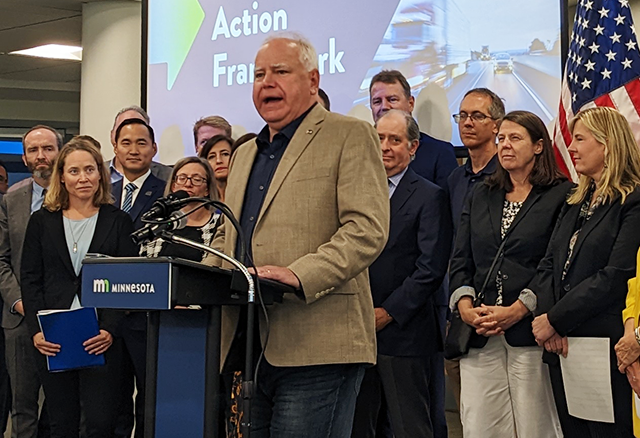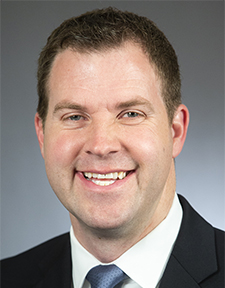In Gov. Tim Walz’s first term, DFLers in Minnesota produced lots of official reports on climate change and had plenty of grand plans meant to address the issue. But nearly all of those proposals stalled in the Republican-held Senate, or failed to even pass the DFL-led House.
With the Legislature now fully in Democratic hands after the November election, leaders are promising an ambitious climate agenda aimed at shrinking carbon emissions.
“Because of the rising awareness of climate change I think there’s more momentum than ever,” said Sen. Nick Frentz, a DFLer from North Mankato who will chair the Senate’s Energy, Utilities and Environment Committee. “I think this year’s Minnesota Legislature is going to pass the most significant climate legislation in history.”
Republicans are likely to oppose most DFL proposals, arguing they are misguided interventions, represent misplaced priorities, might raise costs or threaten power reliability.
But even as Democrats promise to muscle through spending to boost the electric vehicle infrastructure, make homes more energy efficient and spend on other climate initiatives, there will be larger questions to tussle with that could test the narrow DFL majorities in the House and Senate.
Thornier debate over regulations like whether to require electric utilities to be carbon-free by 2040 will dictate how far and how fast Minnesota will move to reshape transportation, electricity production, and other sectors like agriculture.
What’s likely to happen
The exact DFL agenda isn’t yet clear. Frentz said, for instance, that Senate Democrats haven’t discussed specifics of what everyone might support.
But generally, Frentz said he prefers “a carrot more than a stick, incentives more than mandates.” And with a healthy surplus that could be as much as $12 billion, there is more room than usual to spend.
Earlier this year, Gov. Tim Walz’s administration released a “climate action framework” that lawmakers might draw from. And in January, a group of House DFLers focused on climate change rolled out a plan to shrink carbon emissions across Minnesota with a rather hefty $1 billion price tag.
It had 31 spending proposals with big ticket items like $45 million for a renewable energy development fund for Greater Minnesota, $150 million for weatherization work to make houses more energy efficient and $100 million to help schools be more energy efficient. The most expensive item was $200 million to build four bus rapid transit lines. And the work spanned everything from cash to develop new agricultural products to $30 million to plant millions of trees.

After all, House Democrats themselves only passed portions of the plan in the 2022 session as they wrestled with other competing priorities like tax cuts and spending. (No climate spending passed the full Legislature this year.)
“We did have budget targets that were considerably smaller than $1 billion across the committees, so we were more constrained in terms of what we were able to allocate in our budget bills,” said Rep. Jamie Long, a Minneapolis DFLer who currently chairs the House’s climate and energy committee but will be the House Majority Leader next year.

Frentz predicted that balancing spending and other policy goals would prove the bigger question for Democrats than whether enough DFLers would support more climate spending than in years past. He and Acomb wouldn’t estimate what amount could be dedicated for climate policies.
Long, for his part, said many provisions in the $1 billion proposal were “reflected” in the federal Inflation Reduction Act. But he said $1 billion is still a “reasonable request” given the priority climate change has become among Democrats and the general public. And Long noted both he and House Speaker Melissa Hortman — the top two Democrats in the House — both previously ran the energy committee. “I would be surprised if climate didn’t wind up getting a substantial investment from this team,” he said.
Rep. Chris Swedzinski of Ghent, the top Republican on the House’s climate and energy committee, said the GOP would focus on lowering energy costs and returning money to power customers and taxpayers with the surplus rather than other climate projects. And he said he would favor eliminating a nuclear waste storage tax on Xcel Energy that lawmakers use to fund renewable energy projects in a bid to slice energy bills. “The cost of energy is exceptionally high,” Swedzinski said.

However much the DFL spends, the key Democratic leaders outlined a few priorities that are likely to find their way to Walz’s desk.
One is providing matching funds that unlock federal cash for clean energy projects in the $1.2 trillion infrastructure bill, including $68 million for Minnesota to build more EV charging stations.
Minnesota is not on track to meet its current goals to reduce greenhouse gas emissions 30% over 2005 levels by 2025, and 80% by 2050. And state officials say the transportation sector is the largest source of carbon emissions in the state.
Another issue supported by Long, Frentz and Acomb that has garnered bipartisan support in the past is known as “weatherization.” The state’s federally-funded weatherization assistance program helps eligible homeowners and renters with upgrades meant to reduce energy usage, like attic insulation or replacement of a water heater.

An energy spending deal struck by Senate Republicans and House DFLers earlier this year failed to pass the Legislature amid larger disagreements on budget negotiations.
Frentz said he also wants to funnel more money into incentives for agriculture and the Forever Green agriculture research program at the University of Minnesota that develops crops meant to reduce water pollution and carbon emissions. And he said he hopes to find other ways to incentivize industry to reduce emissions.
Acomb said other priorities include more cash for innovating green technology, a program that puts solar arrays on schools and expanding Minnesota’s “community solar garden” initiative that allows people who can’t install panels on their home to buy a piece of a shared solar plot.
Will the Legislature put new regulations on electric utilities, fuel producers?
Democrats have proposed a handful of regulations on industry over the last few years meant to cut carbon. But only some may get a closer look.
A “low carbon fuel standard” that requires fuel producers to make their products cleaner over time doesn’t appear to be a top priority of key DFLers. And both Acomb and Frentz said they wouldn’t push Walz to join California in banning the sale of nearly all new gas-powered vehicles by 2035.
Still, those Democrats say they are targeting a notable regulation on electric utilities, which have made more progress in reducing emissions than the transportation sector.
Walz has championed a policy backed by most DFL legislators that would require electric utilities to distribute carbon-free energy by 2040 and hit benchmarks for clean power along the way.
Supporters say it’s necessary to ensure the electric sector completes its transition away from fossil fuels quickly, as scientists say massive carbon-cutting efforts are needed to prevent the worst impacts of climate change. Long said the state won’t hit President Joe Biden’s goals for cutting carbon emissions without new standards.
But it has been a controversial policy among Republicans, some Democrats and electric utilities.
Xcel Energy has set a goal for carbon-free energy by 2050. And in a statement, company spokeswoman Lacey Nygard said the Inflation Reduction Act has given the company an opportunity to accelerate new technologies that could help the utility eliminate fossil fuels quicker.
But she said any 2040 goal from the state should “include appropriate consideration of affordability and reliability.”
“We are committed to achieving a zero carbon future as quickly as possible — potentially as early as 2040,” Nygard said. “But only if we can do so affordably and reliably. We chose 2050 as our target date to ensure that the technology needed to get us to 100% carbon free electricity has time to mature and become commercial and affordable for our customers.”
At a House hearing for the bill in 2021, Julie Pierce, vice president of strategy and planning for the Duluth utility Minnesota Power said utilities in the state are “leading the nation in our voluntary efforts to move further and faster” and asked for flexibility from lawmakers.
Minnesota Power also has a goal to be carbon free by 2050 and has recently drawn praise from environmental groups for an energy plan that could rid coal from the company earlier than expected and would ramp up wind, solar and energy storage efforts.
Other utilities have debated what should count as clean energy under the rules or also had concerns about what leeway companies would have to maintain the reliability of their systems when wind, solar and other power sources aren’t meeting demand.
Swedzinski, the Ghent Republican, said he worried regulatory mandates would lead to higher costs for businesses and people and serve as part of a DFL goal to eventually rid the energy sector of things like biofuels and diesel-powered tractors. (Democrats do tend to support biofuels but also push for widespread EV adoption.)
It’s unclear whether the 100% policy could garner support in the DFL-led Senate, where Democrats have only a one-vote majority. Incoming Senator Rob Kupec of Moorhead, for instance, told MinnPost earlier this month that he wasn’t sure if Minnesota should set a date for utilities to comply with.
Still, Frentz was optimistic the bill would pass, though he described the legislation as a “goal” for utilities, who can still emit carbon for power if the PUC determines avoiding fossil fuels would threaten reliability or bring unreasonable costs for customers.
Acomb, meanwhile, said she thought the 100% by 2040 bill was “low hanging fruit.”
“We should be able to pass that without problem,” she said. “That’s my hope, that’s my sense.”


0 Commentaires